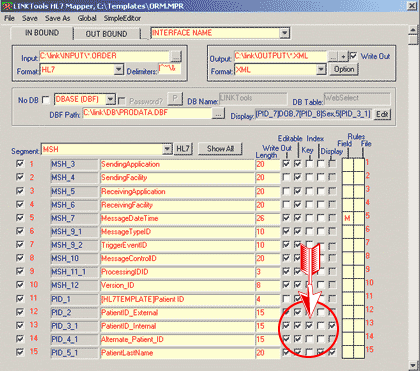

| LINKMED® Interface
Tutorial: HL7 Order and Result Template |
HL7 ORDER (ORM) and RESULT (ORU)Interface Template Construction:
The LINKMED® Interface Engine processed, filtered
and reformatted HL7 ORDER Messagesfrom the receiving folder
of the TCP/IP Receiver based on Mapper pre-configured interface
template . Once transformed the reformatted files are placed
into the pre-determine network directory folder or in the
LINKMED® Interface facility's folder accessible by
other applications. The Original HL7 Orders Records is stored
in the LINKMED® intermediate database; this data is
needed to reconcile with the return Results/Reports before
HL7 Results or Billings message are created and send back
to the HIS.
HL7 ORDER(ORM) Message:
An order is a request for material or services, usually
for a specific patient. These services include medications
from the pharmacy, clinical observations (e.g., vitals,
I&Os) from the nursing service, tests in the laboratory,
food from dietary, films from radiology, linens from housekeeping,
supplies from central supply, an order to give a medication
(as opposed to delivering it to the ward), etc. Most orders
are associated with a particular patient. However, the Standard
also allows a department to order from another ancillary
department without regard to a patient (e.g., floor stock),
as well as orders originating in an ancillary department
(i.e., any application may be the placer of an order or
the filler of an order).
We refer to the person or entity that places the order as
the placer. We refer to the person or entity that carries
out the order as the filler (producer in ASTM terminology).
In the case where the person or entity that carries out
the order also requests the order, this person or entity
is referred to as the filler and placer of the order. The
filler may also request another application to assign a
filler or placer order number. The Order(ORM) Message is
as follow:
MSH…PID…[PD1]…[PV1]…[PV2]..[{IN1}]… [{IN2}]… [{IN3}]… [GT1]… [{AL1}]…ORC…OBR… [{NTE}]
Example:
MSH|^~\&|RIS|WB0|LINKMED|RAD|200807070841||ORM^O01|1|P|2.3.1|
PID||000001234567|000001234567|000006495773|DOE^JANE^
F^^^||19501115|F|||123 ANY STREET^^ANYCITY^WI^53711||6082571234|6082044567|N^|||000101128180|323468612|||W|
PV1|||^^||||||||||||||||000006495773||||||||||||||||||||WB0|
ORC|NW|90001^002|6159034||IP||^^^200307070000^^R^^ROUTINE|||101||108068^GOERGE^W
BUSH.^^^^UWHealth||||^Routine exam|
OBR||90001^002|6159034|CWH^0005^MAMMOGRAM
DIGITAL SCREENING BI^76092||||||101||N|||^^^^|108068^GEORGE^W
BUSH.^^^^UWHealth|||^MG|routine yearly exam||||MG|||1^^^200807070000^^R^^ROUTINE||||^^^SCREENING|
NTE|||cbe normal|
Creating Mapper Template for the INBOUND ORDER Message is similar to that of the INBOUND ADT except that this Interface uses both INBOUND and OUTBOUND feature of the Dynamic Mapper and also utilizes the LINKMED® Intermediate database. The following are HL7 segments selected for this interface from the above HL7 message.
MSH, PID, PV1, ORC, OBR, NTE, OBX
The HL7 ORDER Message example above does not contain HL7 OBX segment but it is selected from the library for carrying " Result Message" back to the HIS. The item in RED are selected as key (Unique Key Identifier), they are MRN and Order Number (PID_3_1 and OBR_3_1) respectively, make sure that the PID_3_1 and OBR_3_1 Key is checked in the Mapper File of the Interface (Figure 1).

Figure 1:LINKMED® Mapper INBOUND HL7 ORDER Key Identifier
Selection